Sightseeing courses
Hirosaki castle town, Kuroishi, Rice Paddy Art, Seibien, Kokeshi house course
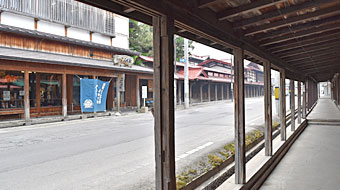
- Course details
Near Hirosaki, there are also gardens and stores which trace the castle town.
Sho-Arashiyama, which is famous for the Maple tree which the lord of the feudal caln brought from Kyoto, can be seen.
Rice Paddy Art in the Tsugaru plain which is famous as a rice producing area.
Ample contents including the “Tsugaru cuisine heritage Kenojiru”course. - The time required
7 hours
- Best season
From July to November
- Sightseeing route
JR Hirosaki station・Hotels inside Hirosaki—Hirosaki park・ Tsugaru-han Neputa Mura—Inaka kan・ rice paddy art—Ogami・ Seibiyen—Kuroishi・ Komise street—Nakano Momiji mountains—Tsugaru Kokeshi House・ folktale and craft house—Kuroishi Onsen Region
Introducing sightseeing spots
Hirosaki park
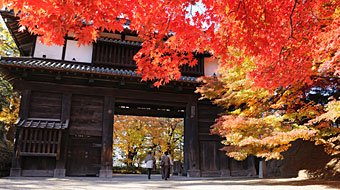
- Points to see
Sakura, which stands close to the castle, maples that turn into deep red, fantastic snow hanging lanterns…
The castle walls which remain the same as the past history.
Inside the park of the area of 42.9 ha (half the size of the Imperial Palace) you can see 2600 sakura trees with 50 sorts, 2200 pine trees, 1200 trees of autumn leaves.
One round takes 2 hours, enjoy walking slowly and experience the history.
Even after coming many times and at what time, one’s heart flutters to this wonderful place. It is the symbol of Hirosaki.
Hirosaki castle
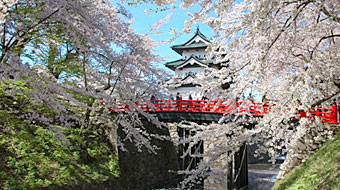
- Points to see
(Important cultural property) The castle which the Tsugaru feudal lords established after the Tsugaru uniformation. The first feudal lord Tamenobu planned the construction and Nobuhira completed the castle in 1611.
Remaining on the grounds are the castle tower, three turrets, five gates.
In the 22nd year of Heisei, 400 years have passed since construction. In the 23rd year of Heisei, the keep has been moved, and the repair of the stone walls have started.
Due to the repair of the stone walls of Hirosaki castle, construction started moving the keep 70m to the inner part. Therefore, the view of the castle is different from the photo. We appreciate your understanding. In the year 2021, the repair of the stone walls is scheduled to end, and the keep will be moved to the former place. - Information for visitors
Admission paid for the keep and the northern wall.
Admission-paid period / April 1 – November 23 9:00~17:00 time required 20 minutes.
Admission fee / “indivisual” adults 310 yen, child 100 yen.
Tsugaru han (clan) Neputa Village
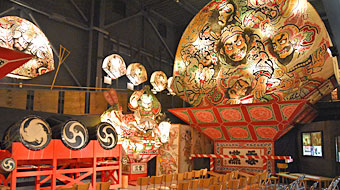
- Points to see
An important intangible folk cultural asset which colors a summer night in Hirosaki. Starting with Hirosaki Neputa, you can see the folkcraft of Tsugaru, hear a live preformance of Tsugaru Shamisen (3 stringed instrument). It is a perfect facility where you can see Tsugaru entirely and experience it.
There is a corner which introduces Mount Iwaki.
While looking at the 10m high huge Neputa, you can enjoy the taiko (drums) and shishi (lion) live performance, and listen to the Tsugaru shamisen performance up close. Why not experience the Tsugaru culture. - Information for visitors
Days off / December 31
Open period / April~November /9:00~17:00, December~March/9:00~16:00 time required 30 minutes
Admission fee / Indivisuals 550 yen, Highschool and junior highschool students 350 yen, elementary students 200 yen, children over 3 years old 100 yen
Inaka-kan (House of country side), Rice paddy art
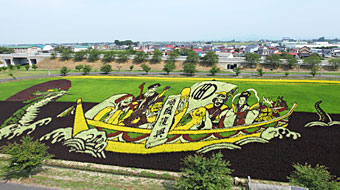
- Points to see
This first started with the design of Mount Iwaki drawn in the 5th year of Heisei along with the letters “Inabunka no murai nakadate”. From “Monalisa” drawn in the 15th year of Heisei, it is called Rice Paddy art since then.
Nowadays the promotion grade rice Tsugaru Roman and ancient purple and yellow rice, new rice of Iwai Akane is colorfully used. During the 4 months until the rice harvesting, 100 thousand to 200 thousand people come to visit.
From the toppest floor of the village office Inaka kan “Inaka-kan jyotenshu”you can have a view. - Information for visitors
open hours / 9:00~16:30
Seibiyen
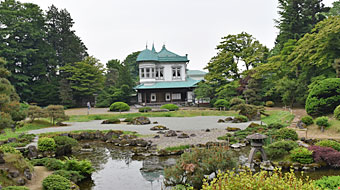
- Points to see
(Government designated historic site) It is a representative japanese garden of Oishi Bigaku Ryu Karesansui kaiyu-shiki.
The garden covers 1.2 ha of land. The construction started in the 35th year of Meiji and was completed in 44th year of Meiji.
The building of semi western style with it’s unique beauty harmonizes with the garden and conceals the appearance of the Meiji period.
Seibiyen became a motif for the movie “Karigurashi no Arietti” one of the works of Studio Jiburi in 2010. - Information for visitors
Temporary closure / the close of the old year to the start of the new year December 29 – January 3
open hours / mid April to September / 9:00~17:00, October to mid November / 9:00~16:30, mid November to mid April / 10:00~15:00.
Admission fee / Adults 430 yen, Junior highschool and Highschool students 270 yen, Elemantary school students 160 yen (group discounts available)
Kuroishi, Komise(little shops) street

- Points to see
It is a castle town of Tsugaru Kuroishi clan. It features an arcade shopping area from the latter period of Edo era.
An arcade made of wood to protect the house from snow, there are a few still in Hirosaki and Tsugaru city, but the Komise in Nakamachi of Kuroishi city stays the same from the Edo period.
It was chosen as one of the best 100 Japanese Roads in the 62nd year of Showa.
Nakano Momiji Mountain
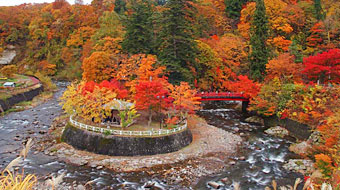
- Points to see
In 1802 (2nd year of Kyowa) , Neishinkou of Tsugaru brought from Kyoto around 100 sorts of Maple seeds and planted them out. It became a beauty spot for the Maples.
In the Nakano shrine in the forest, maples and momi fir of 200 years old, big japanese cedar (sugi) of 500 years old is raised.
The autumn foliage with blazing red leaves shine brilliantly on the fall and stream. The beautiful view is praised.
During the autumn foliage season, there is a lightup of the Momiji until the beginning of November.
Tsugaru Kokeshi House
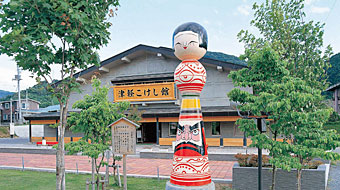
- Points to see
3000 Kokeshi’s with 11types are gathered throughout Japan. The best Jumbo Kokeshi and grain toys are also displayed.
Mori Hidetaro from Nurumayu Onsen of Kuroishi city and Tatsuo Hasegawa from Ohwani have cultivated the tradition of Tsugaru type until today. - Information for visitors
Open hours / 9:00~17:00
Admission fee / Adults 320 yen, Highschool students 270 yen, Elementary and Junior Highschool students 160 yen.
Taxi fees
*taxisite plus is a service provided by the taxisite.
*Regarding the information and photos of sightseeing spots and facilities on the homepage, we do not guarantee the accuracy, reliability and integrity.
*For details of the sightseeing spots and facilities on our homepage (open hours, admission fee), please confirm on the official homepages respectively.
*Admission fee, entrance fee, the cost of food and drink, parking fee, toll road fee are not included in the charge. Customer must bear the actual expenses.
*If during the ride, customer changes the route or cancels the ride for personal reasons, customer must pay for the calculated amount which is applied by temporality charge from the beginning.
*At the sightseeing spots, if the time is extended under a special contract with the customer, customer must pay for the amount which is applied by temporality charge.
*There may be cases in which the driver is not fluent in English. We appreciate your understanding.
*A sightseeing taxi is a service which we drive you to the sightseeing facilities on our taxi according to the sightseeing courses decided in advance. It is not a service which a travel agency provides, therefore our driver will not provide comment on the sightseeing facilities and guide you. It is possible to drive you to the sightseeing facilities which are not on the sightseeing courses. If you would like to visit optional sightseeing facilities or sightseeing courses, please contact us from the e-mail inquiry form.
Reservations, inquiries about sightseeing taxi
For reservations and inquiries of sightseeing taxi, please contact the following telephone number or e-mail form.
TEL: 0172-33-3333


